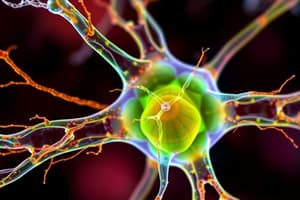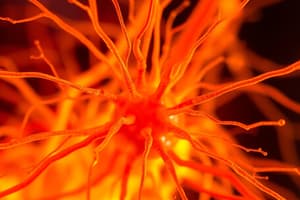Podcast
Questions and Answers
What is the function of the inner membrane folds called cristae in a mitochondrion?
What is the function of the inner membrane folds called cristae in a mitochondrion?
- Decrease surface area
- Contain pigments
- Increase surface area (correct)
- Store carbohydrates
Where are chloroplasts typically found?
Where are chloroplasts typically found?
- In bacteria
- In plants and algae (correct)
- In fungi
- In animal cells
Which characteristic supports the endosymbiont theory regarding the evolutionary origins of mitochondria and chloroplasts?
Which characteristic supports the endosymbiont theory regarding the evolutionary origins of mitochondria and chloroplasts?
- No involvement in cellular respiration
- Presence of a single membrane
- Having similarities with bacteria (correct)
- Lack of DNA and ribosomes
What is a key feature that distinguishes eukaryotic cells from prokaryotic cells?
What is a key feature that distinguishes eukaryotic cells from prokaryotic cells?
Which organelle is responsible for using solar energy to synthesize carbohydrates?
Which organelle is responsible for using solar energy to synthesize carbohydrates?
Why is the matrix of a mitochondrion important?
Why is the matrix of a mitochondrion important?
Which component of the cytoskeleton is described as a ropelike assembly and runs from the nuclear envelope to the plasma membrane?
Which component of the cytoskeleton is described as a ropelike assembly and runs from the nuclear envelope to the plasma membrane?
Which motor protein is instrumental in muscle contraction by interacting with actin?
Which motor protein is instrumental in muscle contraction by interacting with actin?
What is the primary function of microtubules within the cell?
What is the primary function of microtubules within the cell?
What is the major extracellular component found in animals that provides support and varies in flexibility depending on the tissue?
What is the major extracellular component found in animals that provides support and varies in flexibility depending on the tissue?
How do cilia differ from flagella in terms of structure and function?
How do cilia differ from flagella in terms of structure and function?
Which structure with nine triplets of microtubules arranged in a ring is only found in animal cells and plays a role in cell division?
Which structure with nine triplets of microtubules arranged in a ring is only found in animal cells and plays a role in cell division?
What is the primary function of the mitochondria in a eukaryotic cell?
What is the primary function of the mitochondria in a eukaryotic cell?
Where are ribosomes responsible for protein synthesis found in eukaryotic cells?
Where are ribosomes responsible for protein synthesis found in eukaryotic cells?
What is the evolutionary origin of mitochondria and chloroplasts in eukaryotic cells, according to the endosymbiont theory?
What is the evolutionary origin of mitochondria and chloroplasts in eukaryotic cells, according to the endosymbiont theory?
Which organelle is responsible for capturing light energy and converting it into glucose in plant cells?
Which organelle is responsible for capturing light energy and converting it into glucose in plant cells?
What is the function of the cytoskeleton in a eukaryotic cell?
What is the function of the cytoskeleton in a eukaryotic cell?
Which organelle is responsible for generating most of the ATP in a eukaryotic cell through cellular respiration?
Which organelle is responsible for generating most of the ATP in a eukaryotic cell through cellular respiration?
Flashcards are hidden until you start studying
Study Notes
Mitochondria and Cristae
- Cristae are inner membrane folds in mitochondria that increase surface area for ATP production.
- Mitochondria are primary energy producers in eukaryotic cells.
Chloroplasts
- Chloroplasts are typically found in plant cells and some protists.
- They convert solar energy into chemical energy through photosynthesis.
Endosymbiont Theory
- The theory suggests that mitochondria and chloroplasts originated from engulfed prokaryotic cells.
- Both organelles have their own DNA, similar to bacterial DNA structure, supporting this theory.
Eukaryotic vs. Prokaryotic Cells
- Eukaryotic cells have a defined nucleus and membrane-bound organelles, unlike prokaryotic cells.
Solar Energy Utilization
- Chloroplasts are responsible for using solar energy to synthesize carbohydrates through the process of photosynthesis.
Mitochondrial Matrix
- The matrix is crucial for the citric acid cycle, where energy carriers are produced for cellular respiration.
Cytoskeleton Components
- Intermediate filaments are ropelike assemblies of proteins that provide structural support from the nuclear envelope to the plasma membrane.
Motor Proteins and Muscle Contraction
- Myosin is the motor protein that interacts with actin filaments to facilitate muscle contraction.
Microtubule Function
- Microtubules are involved in maintaining cell shape, transport within the cell, and separating chromosomes during cell division.
Extracellular Matrix in Animals
- Collagen is the major extracellular component in animals, providing structural support and varying in flexibility based on tissue type.
Cilia vs. Flagella
- Cilia are short and numerous, moving fluid across the cell surface, while flagella are longer and usually singular, propelling the cell itself.
Centrosomes
- Centrosomes contain structures with nine triplets of microtubules arranged in a ring, critical for organizing microtubules during cell division.
Mitochondrial Function
- The primary function of mitochondria is to generate ATP through cellular respiration, providing energy for the cell.
Ribosomes in Eukaryotic Cells
- Ribosomes responsible for protein synthesis are found in the cytoplasm, on the rough endoplasmic reticulum, and within mitochondria.
Evolutionary Origin of Organelles
- According to the endosymbiont theory, mitochondria and chloroplasts are thought to have evolved from free-living bacteria that were engulfed by ancestral eukaryotic cells.
Light Energy in Plant Cells
- Chloroplasts capture light energy and convert it into glucose during photosynthesis.
Cytoskeleton Function
- The cytoskeleton provides structural support, maintains cell shape, and enables cell movement and division in eukaryotic cells.
ATP Production
- Mitochondria are the main organelles responsible for generating the majority of ATP in eukaryotic cells through the process of cellular respiration.
Studying That Suits You
Use AI to generate personalized quizzes and flashcards to suit your learning preferences.




